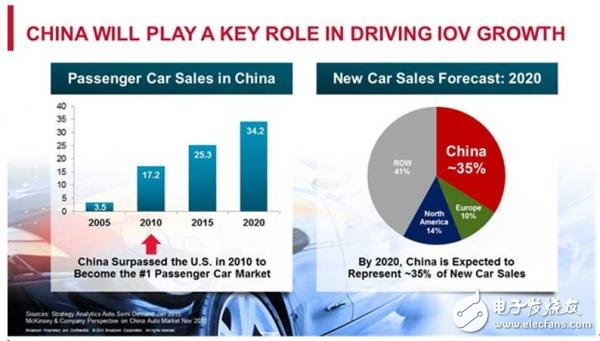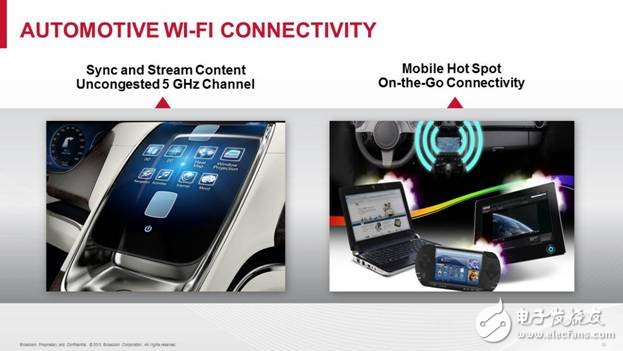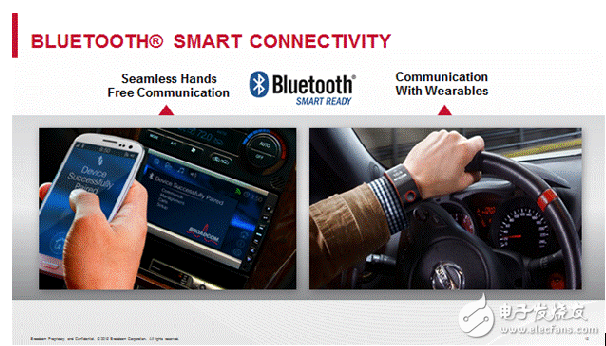With the advent of the Internet of Things era, we are expected to live in a world dominated by hyperlinks. In the broad field of the Internet of Things, the Internet of Vehicles is one of the fastest growing market segments. The impact of this groundbreaking change on automotive design has been particularly noticed by the Chinese market. Connected cars all the way east In 2010, China surpassed the US to become the world's leading new car sales market. By 2020, China is expected to account for nearly 35% of the global new car market. Today, people are paying more attention to the integration of in-vehicle connectivity. The core idea of ​​connected cars is to use semiconductor chips to achieve connectivity. As technology continues to innovate, analysts predict that by 2020 the number of chips per vehicle will approach 1,000. Let's take a closer look at the various leading technologies that drive the development of the Internet of Vehicles. Wi-Fi wireless connection Car Wi-Fi is like a game changer. Analysts predict that by 2019, the number of in-vehicle applications supporting Wi-Fi will increase by eight times. Integrating 5G Wi-Fi technology with the latest wireless 802.11ac standard will enable drivers and passengers to synchronize and transmit content from mobile devices to the vehicle's infotainment system and rear-seat display via a smooth 5 GHz channel on. Automakers can take advantage of in-vehicle Wi-Fi to implement software upgrades and new features. Drivers can use their mobile devices to remotely view their vehicle position, fuel volume and mileage, as well as receive early warning information about vehicle performance and diagnostics on the same mobile device. In addition, the in-vehicle Wi-Fi technology can also set up a mobile hotspot to connect to the network without relying on cellular devices and moving. Wi-Fi is also expected to play a key role in V2X (vehicle-to-everything) communication and unmanned driving. The Wi-Fi advantage is even more pronounced as standards for supporting Gigabit and higher rates continue to evolve. Based on the latest 802.11ac standard, 5GWiFi technology allows drivers and passengers to easily synchronize the contents of mobile devices in the car and transmit them to the car's infotainment system and rear seat display. Bluetooth® and Smart Bluetooth For years, Bluetooth has become synonymous with car hands-free phones. Energy-saving technology called "smart Bluetooth" or "Low Energy Bluetooth" (BLE) is one of the important technologies for the development of Bluetooth in the car. With BLE, Bluetooth can work with very little power, and after a single charge, the battery can last for months or even years. Smart watches, sphygmomanometers, pulse monitors, alcohol monitors, or blood glucose monitors will be the first wave of wearable devices that connect to the vehicle. Currently, Apple and Android systems have supported low-power Bluetooth (BLE) technology, and a low-power ecosystem has gradually taken shape. As Broadcom and other companies introduce semiconductor chips that support Bluetooth low-power (BLE) capabilities, the ecosystem will expand into the automotive sector in the near future. Bluetooth Smart Ready technology will play a vital role in the implementation of vehicle-to-wear technology connectivity, including the monitoring of biometrics such as fatigue driving, blood alcohol levels, and blood glucose levels.
Power Meter is a monitoring and testing instrument which determines the power consumption of a connected appliance and the cost of the electricity consumed. LCD Display Power Meter Socket,Power Meter Plug Outlet,Electricity Usage Monitor Socket,LCD Energy Power Meter Socket,Digital LCD Power Meter Socket NINGBO COWELL ELECTRONICS & TECHNOLOGY CO., LTD , https://www.cowellsockets.com


Built-in 3.6V rechargeable Batteries ( . The purpose of the batteries is to store the total electricity and memory setting
Resetting
If an abnormal display appears or the buttons produce no response, the instrument must be reset. To do this,
press the RESET button.
Display Mode
Entire LCD can be displayed for about 1 minute and then it automatically gets into Model. To transfer from
one mode to the other, press the FUNCTION button.
Mode 1: Time/Watt/Cost Display Display duration(how long) this device connect to power source.LCD on first line shows 0:00 with first two figures mean minutes(2 figures will occur while occur at 10 min) and the rest shows seconds. After 60mins, it displays 0:00 again with first two numbers meas hour(2 figures will occur at 10hours)and the rest shows minutes. The rest can be done in the same manner which means after 24 hours, it will re-caculate. LCD on second line displays current power which ranges in 0.0W 〜 9999W. LCD on third line displays the current electricity costs which ranges in O.Ocost 〜 9999cost. It will keep on O.OOcost before setting rate without other figures.
Mode 2: Time/Cumulative electrical quantity Display Display duration(how long) this device connect to power source.
LCD on first line shows 0:00 with first two figures mean minutes(2 figures will occur while occur at 10 min) and the rest shows seconds. After 60mins, it displays 0:00 again with first two numbers meas hour(2 figures will occur at 10hours)and the rest shows minutes. The rest can be done in the same manner which
means after 24 hours, it will re-caculate. LCD on second line displays current cumulative electrical quantity which ranges in 0.000KWH 〜 9999KWH without other figures. LCD on third line displays"DAY"- "1 'Will be showed on numerical part(the other three figures will be showed at carry) which means it has cumulated electrical quantity for 24hours(one day). The rest can be done in the same manner untill the maximal cumulative time of 9999 days.
Mode 3: TimeA^bltage/Frequency Display LCD on first line displays the same as Mode 1 dones. LCD on second line displays current voltage supply (v) which ranges in 0.0V 〜 9999V .LCD on third line displays current frequency (HZ) which ranges in 0.0HZ 〜 9999Hz without other figures.
Mode 4: Time/Current/Power Factor Display LCD on first line displays the same as Mode 1 dones.LCD on second line displays load current which ranges in 0.0000A 〜 9999A. LCD on third line displays current power factor which ranges in 0.00PF 〜 LOOPF without other figures.
Mode 5:Time/Minimum Power Display LCD on first line displays the same as Mode 1 dones. LCD on
second line displays the minimum power which ranges in 0.0W 〜 9999W. LCD on third line displays character of "Lo" without other figures.
Mode 6: Time/Maximal Power Display LCD on first line displays the same as Mode 1 dones. LCD on second line displays the maximal power which ranges in 0.0W 〜 9999W. LCD on third line displays character of "Hi" without other figures.
Mode 7: Time/Price Display LCD on first line displays the same as Mode 1 dones. LCD on third line displays the cost which ranges in O.OOCOST/KWH 〜 99.99COST/KWH without other figures.
Overload Display: When the power socket connects the load over 3680W, LCD on second line displays the''OVERLOAD[ with booming noise to warn the users,( 1918928,selectable choice)
Supplemental informations:
1: Except [OVERLOAD[ interface, LCD on first line display time in repitition within 24hours.
2: LCD on first line, second line or third line described in this intruction take section according to two black lines on LCD screen. Here it added for clarified purpose.
3. Mode 7 will directly occur while press down button "cost".
4. [UP"&"Down" are in no function under un-setting mode.
Setting Mode
1. Electricity price setting
After keeping COST button pressed lasting more than 3 seconds(LCD on third line display system defaults price, eg O.OOCOST/KWH ),the rendered content begins moving up and down which means that the device
has entered the setting mode. After that, press FUNCTION for swithing , then press "UP"and "DOWN" button again to set value which ranges in OO.OOCOST/KWH 〜 99.99COST/KWH. After setting all above, press COST to return to Mode7 or it will automatically return to Mode7 without any pressing after setting with data storage.